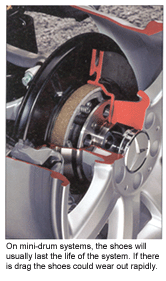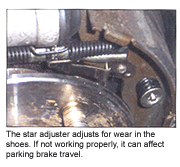On some vehicles it is the forgotten fourth pedal. The emergency or parking brake is a critical component of the brake systems that should not be ignored. Though most motorists seldom use their parking brakes, it is a required safety device and must work properly when called upon to keep a vehicle stationary.
The main function of the parking brake is to prevent the vehicle from rolling when it is parked. But PARK serves the same purpose in vehicles with automatic transmissions, as does leaving a manual transmission in gear. So to many people, the parking brake seems unnecessarily redundant. Even so, it should be used – at least occasionally.
 When the parking brake is seldom used, one of two things can happen: it may stick and not release when applied, or it may allow brake pedal travel to increase.
When the parking brake is seldom used, one of two things can happen: it may stick and not release when applied, or it may allow brake pedal travel to increase.
Using the parking brake helps keep the cables freed up so corrosion can’t buildup and cause the cables to bind. Applying the parking brake also works the self-adjusters in the rear brakes and helps keep the linings in drum brakes properly adjusted for minimum pedal travel. On cars with four-wheel disc brakes and locking rear calipers, using the parking brake keeps the threaded self-adjusting mechanisms inside the rear caliper pistons working freely to compensate for pad wear.
The parking brake also has a secondary purpose. It’s also an emergency brake. Should both hydraulic circuits fail, the driver can always yank on the parking brake to slow the vehicle down. The stopping power provided by the rear brakes is marginal, but better than nothing.
The parking brake system is pretty simple. On vehicles with rear drum brakes, applying the parking brake pulls a pair of cables that are attached to arms on the secondary brake shoes. This forces both pairs of shoes outward against the drums to lock the brakes. On four-wheel disc brake applications, the disc brake pads are pushed against the rotor by the caliper pistons. This requires either a cam or screw mechanism inside the caliper piston that pushes the piston out and holds it there, or a mini-drum brake inside the rear rotor.
On rear disc brake applications with locking calipers, the adjustment of the parking brake cable is especially important. If the cable is adjusted too tight, there may not be sufficient travel to work the self-adjusters and/or the brakes may drag. If the cable is adjusted too loose, the parking brake may not hold the vehicle. As a rule, most hand levers should travel only about four or five “clicks” when properly adjusted.
On rear disc brake applications with mini-drums in the rotors, the parking brake works like a conventional duo-servo drum parking brake. Pulling the cable forces the shoes outward against the drum to lock the wheel. But unlike a full-sized drum brake, there’s no self-adjuster mechanism for the star wheel to compensate for shoe wear. The only time the parking brake is applied is when the vehicle is at rest, so the shoes should last the life of the vehicle unless the parking brake is not releasing causing the shoes to drag. The thickness of the shoe linings doesn’t really matter as long as there is enough lining left to hold the car on an incline with normal cable travel.
 On most vehicles, the left and right parking brake cables come together and are attached to a lever linkage called an “equalizer” yoke under the vehicle. The equalizer yoke balances, or equalizes, the amount of force that’s applied to both cables when the parking brake is applied. The equalizer linkage, in turn, is connected to a single cable that runs to the parking brake lever or pedal. An adjustment screw may be located on the front cable where it connects to the equalizer, or where the cable attaches to the parking brake lever.
On most vehicles, the left and right parking brake cables come together and are attached to a lever linkage called an “equalizer” yoke under the vehicle. The equalizer yoke balances, or equalizes, the amount of force that’s applied to both cables when the parking brake is applied. The equalizer linkage, in turn, is connected to a single cable that runs to the parking brake lever or pedal. An adjustment screw may be located on the front cable where it connects to the equalizer, or where the cable attaches to the parking brake lever.
Rust is the main concern with the brake cables and linkage. Rust can cause the cables to bind in their sheaths, preventing the brakes from being applied or released. If one cable freezes up, the equalizer can’t do its job and only one wheel will lock. Though this may not create a problem when the parking brake is used for parking, it could create a serious brake imbalance should the system ever be called upon for emergency braking. The imbalance would likely cause one wheel to lock up and skid, throwing the vehicle into a spin.
The equalizer linkage can also rust up, interfering with proper application and release. Also inspect the hinge pivot because it can break loose, rendering the parking brake useless.
When doing a brake job, therefore, always check the operation of both parking brake cables and the equalizer linkage. Apply the parking brake to see if the linkage is working properly and that the brakes will hold the vehicle. Then check to see that the brakes release fully. If there’s any binding and/or corrosion, clean and lubricate the cables (if possible) or replace them. Also lubricate the pivot point on the equalizer linkage.













